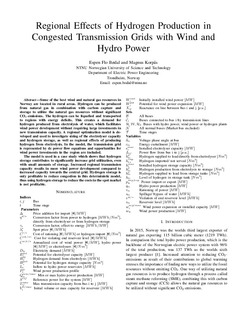| dc.contributor.author | Bødal, Espen Flo | |
| dc.contributor.author | Korpås, Magnus | |
| dc.date.accessioned | 2017-08-24T08:00:05Z | |
| dc.date.available | 2017-08-24T08:00:05Z | |
| dc.date.created | 2017-08-22T10:53:34Z | |
| dc.date.issued | 2017 | |
| dc.identifier.isbn | 978-1-5090-5499-2 | |
| dc.identifier.uri | http://hdl.handle.net/11250/2451692 | |
| dc.description.abstract | Some of the best wind and natural gas resources in Norway are located in rural areas. Hydrogen can be produced from natural gas in combination with carbon capture and storage to utilize the natural gas resources without significant CO2-emissions. The hydrogen can be liquefied and transported to regions with energy deficits. This creates a demand for hydrogen produced from electrolysis of water, which facilitates wind power development without requiring large investments in new transmission capacity. A regional optimization model is developed and used to investigate sizing of the electrolyser capacity and hydrogen storage, as well as regional effects of producing hydrogen from electrolysis. In the model, the transmission grid is represented by dc power flow equations and opportunities for wind power investments in the region are included. The model is used in a case study which shows that hydrogen storage contributes to significantly increase grid utilization, even with small amounts of storage. Increased regional transmission capacity results in more wind power development compared to increased capacity towards the central grid. Hydrogen storage is only profitable to reduce congestion in this deterministic model, thus using hydrogen storage to reduce the costs in the spot market is not profitable. | nb_NO |
| dc.language.iso | eng | nb_NO |
| dc.publisher | IEEE | nb_NO |
| dc.relation.ispartof | 2017 14th International Conference on the European Energy Market - EEM 2017 | |
| dc.subject | Energiplanlegging | nb_NO |
| dc.subject | Energy Planning | nb_NO |
| dc.title | Regional Effects of Hydrogen Production in Congested Transmission Grids with Wind and Hydro Power | nb_NO |
| dc.type | Chapter | nb_NO |
| dc.description.version | acceptedVersion | nb_NO |
| dc.subject.nsi | VDP::Elkraft: 542 | nb_NO |
| dc.subject.nsi | VDP::Electrical power engineering: 542 | nb_NO |
| dc.identifier.doi | 10.1109/EEM.2017.7982013 | |
| dc.identifier.cristin | 1487816 | |
| dc.relation.project | Norges forskningsråd: 255107 | nb_NO |
| dc.description.localcode | © 2017 IEEE. Personal use of this material is permitted. Permission from IEEE must be obtained for all other uses, in any current or future media, including reprinting/republishing this material for advertising or promotional purposes, creating new collective works, for resale or redistribution to servers or lists, or reuse of any copyrighted component of this work in other works. This is the authors' accepted and refereed manuscript to the article. | nb_NO |
| cristin.unitcode | 194,63,20,0 | |
| cristin.unitname | Institutt for elkraftteknikk | |
| cristin.ispublished | true | |
| cristin.fulltext | postprint | |
| cristin.qualitycode | 1 | |
